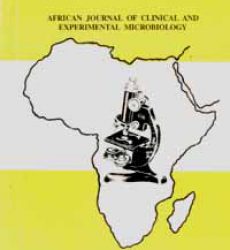THE EFFECT OF SCHISTOSOMA MANSONI CERCARIA INFECTION AND TREATMENT WITH NIRIDAZOLE ON TESTICULAR HISTOLOGY OF THE MICE
Abstract
The testicular histology of mice infected with Schistosoma mansoni (S.mansoni) cercaria and treated with Niridazole was examined. The results reveal that infection of mice with Schistosoma mansoni cercariae resulted in distortion of the testicular cyto-architecture including disruption of spermatogenesis as shown by the absence of spermatozoa in the lumen of the sominiferous tubule and distruction of the inter-tubular connective tissue of the infected mice. These changes were reversed to normalcy following two-course treatment of the infected mice with Niridazole after five weeks.
(Af. J. of Clinical and Experimental Microbiology: 2003 4(1): 2-5)
Investigation of the efficacy of two rapid assessment techniques (Optimal 1 and SD-Bioline) for the diagnosis of malaria in rural areas of Nigeria
Abstract
(Af. J. of Clinical and Experimental Microbiology: 2003 4(1): 6-13)
Evaluation of the OptiMAL Test for Rapid Diagnosis of Malaria
Abstract
(Af. J. of Clinical and Experimental Microbiology: 2003 4(1): 14-17)
Download PDF below
Evaluation of the OptiMAL Test for Rapid Diagnosis of Malaria
Malaria morbidity amongst hospital workers in Ilorin
Abstract
A study of malaria as a cause of morbidity among the staff of the University of Ilorin Teaching Hospital, Ilorin, Nigeria was carried out from August to October 2001. Patients attending a community based Health Centre was used as control. Malaria accounted for 43.0% of illnesses among the workers and 36.7% in the general public. Malaria was responsible for nearly two-thirds of sickness absence and for 48.6% of days lost due to illnesses. Also the disease was responsible for 50 percent or more of sickness absence among all categories of workers when analyzed by occupations. These findings show that malaria could disrupt the health care delivery of a country since it could affect even health workers. By extension too, it could result in the disruption of the economic activities of the country and result in low productivity if not effectively controlled. It I therefore recommended that all efforts at effective controlling malaria should be put in place in Nigeria.
(Af. J. of Clinical and Experimental Microbiology: 2003 4(1): 18-23)
Download PDF below
Parasitic dermatoses as seen at the University of Benin Teaching Hospital (UBTH), Benin City In Nigeria
Abstract
(Af. J. of Clinical and Experimental Microbiology: 2003 4(1): 24-30)
Profile of potentially pathogenic intestinal parasites and bacterial agents in solid wastes in Ibadan municipality
Abstract
Cases of multiple parasites and bacterial agents were commonly encountered in the sludge refuse samples. The commonly found parasitic agents were of both human and veterinary importance. These included Ascaris lumbricoides (9.3 epg), Entamoeba histolytica (8,07 cyst per gram); Hookworm/strongyle (6.27 epg) and Ascaris suum (1.07 epg). Others are Ascaris vitolorum (1.09 epg) Stongyloides papillosu (0.52 larvae/g) Schistosoma suis (0.31 epg) and Dicrocoelium dendriticum whilst the most commonly found bacterial agents were Klebsiella species, Escherichia coli, Proteus specie, streptococci and other gram-positive organisms. Climatic conditions affected the distribution of both parasites and bacterial agents in the sludge (P<0.001). more intestinal parasites (53.4%) and bacterial agents (27.2%) were encountered at mean air temperature 26.1 0.60C, mean relative humidity of 72 3.5%. The degree of contamination by market location varies significantly (P<0.001) A high degree of contamination of solid waste dumpsites with bacterial and bacterial and parasitic agents was observed in the present study. As a result of the public importance of the organisms isolated it is opined that well planned waste management and health education programs will go a long way to reduce the potential epidemic risks posed by such sites in Ibadan, Nigeria. it is believed that economic advantage could be taken of the mountainous solid waste dump by establishing fertilizer-processing plant to produce fertilizer for farmers and provide job opportunity for youths in the area.
(Af. J. of Clinical and Experimental Microbiology: 2003 4(1): 31-43)
Cutaneous and intestinal myiases in Lagelu L.G.A of Oyo State
Abstract
Patients’ conditions gradually improved after recovery of the larvae from them. This report constitutes the first recorded autaneous and intestinal myiases in this rural area, albeit many such cases in the past have gone unrecorded.
(Af. J. of Clinical and Experimental Microbiology: 2003 4(1): 44-47)
Download PDF below
Cutaneous and intestinal myiases in Lagelu L.G.A of Oyo State.
Antibiotic sensitivity of isolates of Pseudomonas aeruginosa in Enugu, Nigeria
Abstract
The pattern of antibiotic sensitivity of 229 clinical isolates of Pseudomonas aeruginosa isolated between June 1998 and May 2000 at the University of Nigeria Teaching Hospital (UNTH) Enugu was studied. The isolates were recovered from various clinical specimens by culturing on standard media viz: blood agar, macConkey agar and Cled agar and identified by routine procedures. Antibiotic sensitivity tests were performed by the disc diffusion technique employing multidisc (habdisc) and using sensitivity test agar incubated at 370C for 24 hours. The results were read and interpreted according to the manufacturer’s instructions. Majority of the isolates tested were susceptible to Ceftazidime (88.5%), Colistin (83.75%), Ciprofloxacine (62.1%) and Ofloxacin (62.5%). Non-urinary isolates were more sensitive than the urinary isolates to of floxacine, Gentamycin, Streptomycin, Ceftriaxine and Cephtazidime. Similar incidence of resistance was observed between the two groups to other antibiotics. Efforts must be made to improve infection control practises, improve antimicroial utilization practices and establish an antibiotic policy for the country.
(Af. J. of Clinical and Experimental Microbiology: 2003 4(1): 48-51)
Methicilin-resistant Staphylococcus aureus (MRSA) at Jos University Teaching Hospital
Abstract
(Af. J. of Clinical and Experimental Microbiology: 2003 4(1): 52-55)

